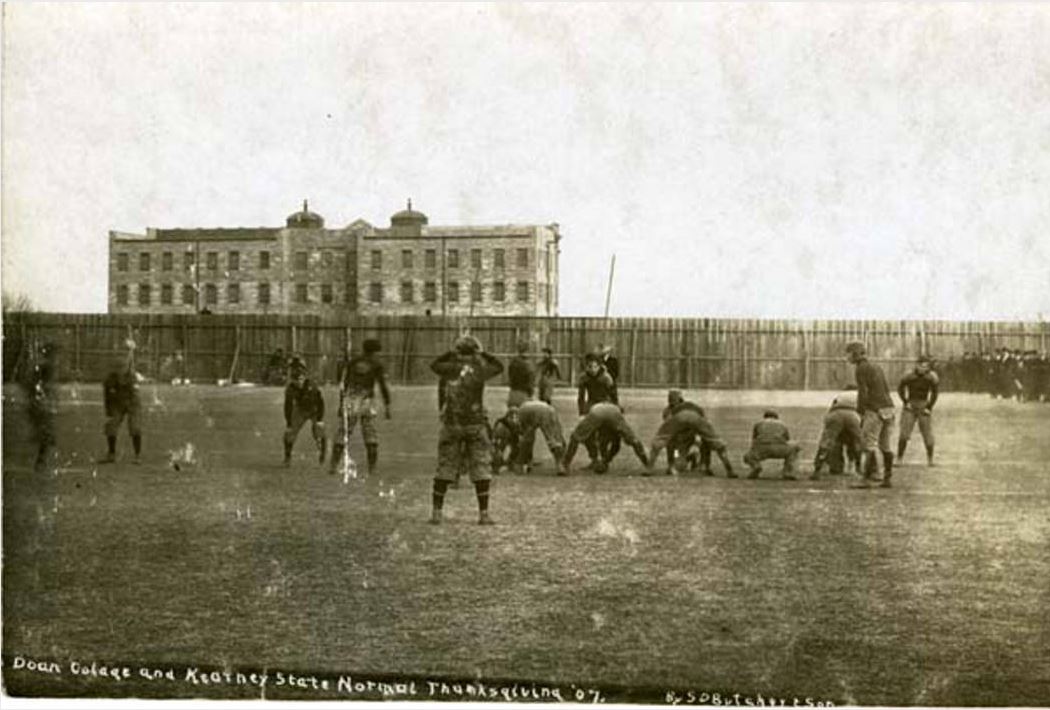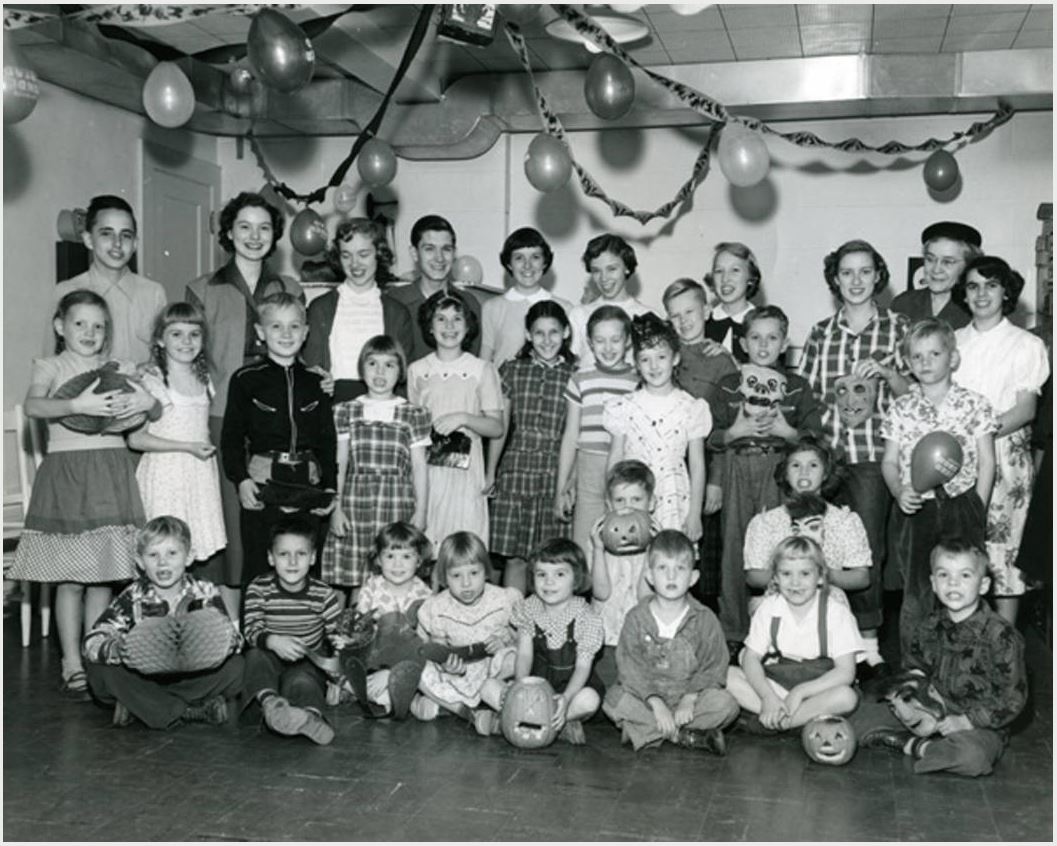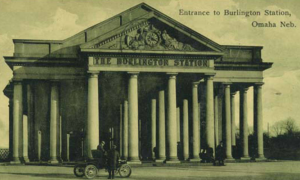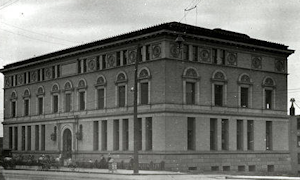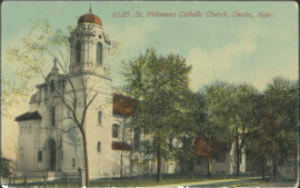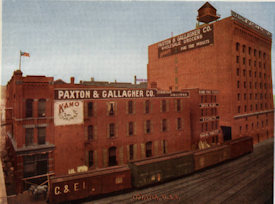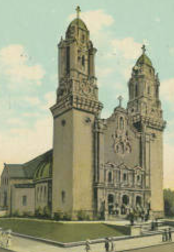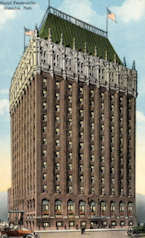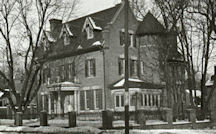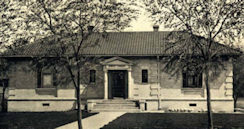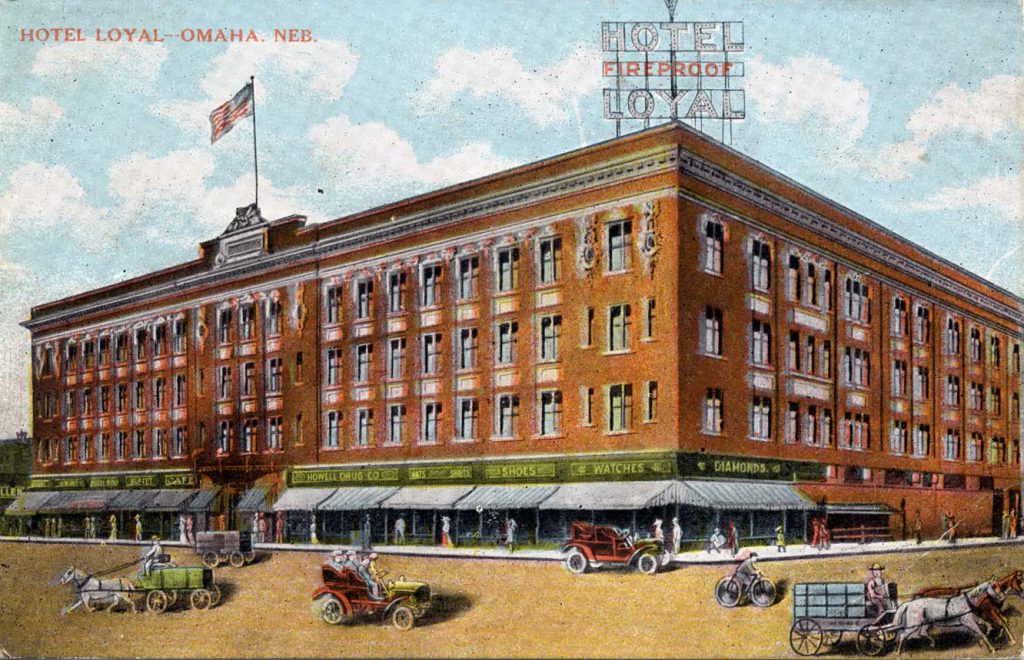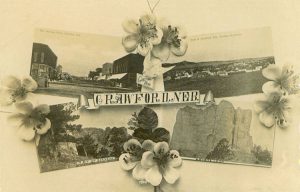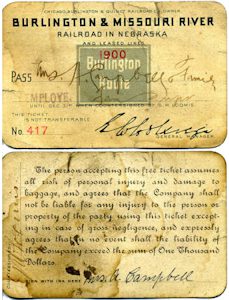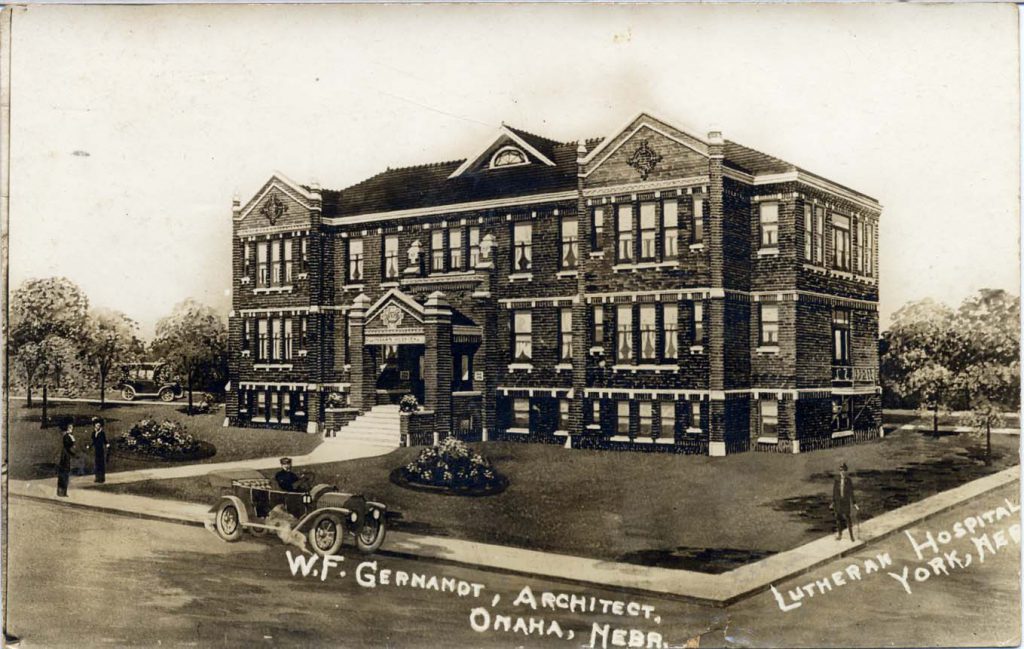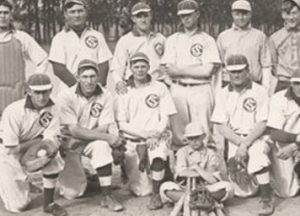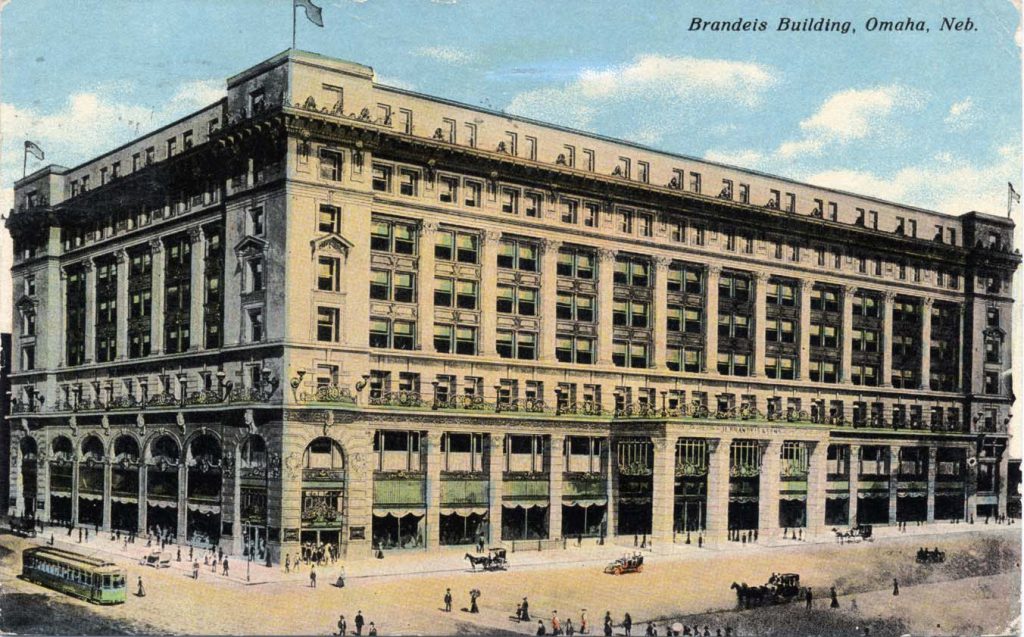Search the Blog
Categories
- Books & Reading
- Broadband Buzz
- Census
- Education & Training
- General
- Grants
- Information Resources
- Library Management
- Nebraska Center for the Book
- Nebraska Libraries on the Web
- Nebraska Memories
- Now hiring @ your library
- Preservation
- Pretty Sweet Tech
- Programming
- Public Library Boards of Trustees
- Public Relations
- Talking Book & Braille Service (TBBS)
- Technology
- Uncategorized
- What's Up Doc / Govdocs
- Youth Services
Archives
Subscribe
Category Archives: Nebraska Memories
Throwback Thursday: Football game near Old Main
Happy Thanksgiving! Let’s celebrate with a 1907 Thanksgiving #ThrowbackThursday!
Back in 1907, fans and spectators gathered to watch Nebraska State Normal School (NSNS) at Kearney play Doane College in a Thanksgiving day football game. In this 5-1/2″ x 3-1/2″ black and white postcard, we can see the two football teams facing off, a group of spectators standing against a tall wooden plank fence, and in the background, the NSNS Administration Building. Written at the bottom of the card is: “Doan Colage and Kearney State Normal, Thanksgiving ’07 By SD Butcher & Son”.
Interested in Nebraska history? Find out more about this photo in the Nebraska Memories archive! Photo provided by the University of Nebraska at Kearney, Archives, Calvin T. Ryan Library located in Nebraska Memories.
Nebraska Memories is a cooperative project to digitize Nebraska-related historical and cultural heritage materials and make them available to researchers of all ages via the Internet. The Nebraska Memories archive is brought to you by the Nebraska Library Commission. If your institution is interested in participating in Nebraska Memories, see http://nlc.nebraska.gov/nebraskamemories/participation.aspx for more information.
Throwback Thursday: Old Style Threshing Outfit
It’s a tribute to the harvest season with this week’s #ThrowbackThursday!
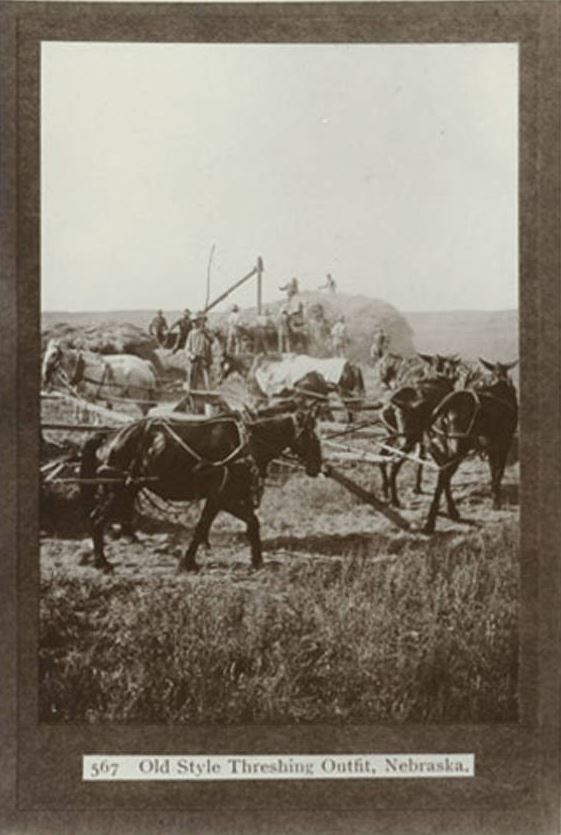
This week we have a 1907-1917 black and white photograph on a postcard. It depicts a group of men threshing wheat with horses attached to a threshing machine as they walk in a circle. In the background is a stack of hay or wheat and more men. Information printed on item: 567 Old Style Threshing Outfit, Nebraska.
Are you interested in Nebraska’s history? Find out more about this photo in the Nebraska Memories archive! Photo provided by the Nebraska State Historical Society located in Nebraska Memories.
Nebraska Memories is a cooperative project to digitize Nebraska-related historical and cultural heritage materials and make them available to researchers of all ages via the Internet. The Nebraska Memories archive is brought to you by the Nebraska Library Commission. If your institution is interested in participating in Nebraska Memories, see http://nlc.nebraska.gov/nebraskamemories/participation.aspx for more information.
Posted in General, Nebraska Memories
Tagged #ThrowbackThursday, Agriculture, Fall, Farming, Harvest, History, Nebraska, Nebraska Memories, Threshing, Throwback Thursday
Leave a comment
Throwback Thursday: Nebraska Veterans
NLC is proud to honor Nebraska’s many Veterans with this week’s #ThrowbackThursday.
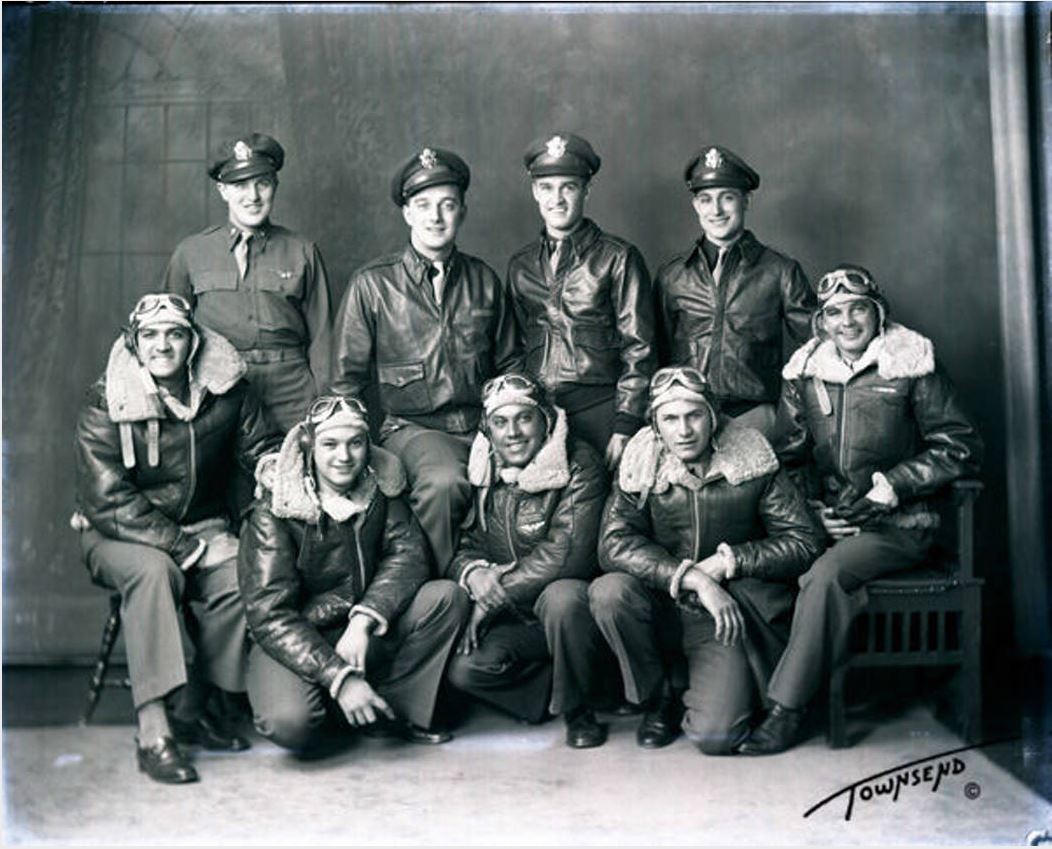 This week we have an 8″x10″ glass plate negative of Lieutenant M.J. Coulter and bomber crew, taken December 6th, 1943. Identified in the photograph are M. Coulter, standing second from the left; W.H. Field, bottom row right and R.D. Espana, bottom row center.
This week we have an 8″x10″ glass plate negative of Lieutenant M.J. Coulter and bomber crew, taken December 6th, 1943. Identified in the photograph are M. Coulter, standing second from the left; W.H. Field, bottom row right and R.D. Espana, bottom row center.
Are you interested in Nebraska’s military history? Find out more about this photo and other military items in the Nebraska Memories archive! Photo provided by the Townsend Studio collection located in Nebraska Memories.
Nebraska Memories is a cooperative project to digitize Nebraska-related historical and cultural heritage materials and make them available to researchers of all ages via the Internet. The Nebraska Memories archive is brought to you by the Nebraska Library Commission. If your institution is interested in participating in Nebraska Memories, see http://nlc.nebraska.gov/nebraskamemories/participation.aspx for more information.
Posted in General, Nebraska Memories
Tagged #ThrowbackThursday, History, Military, Nebraska, Nebraska Memories, Throwback Thursday, Veterans, Veterans Day
Leave a comment
Looking at the Postmarks
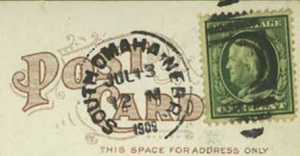 There are over 1,000 postcards in Nebraska Memories and many of them include images of both the front and backs of the cards. I’ve always found it entertaining to read the messages written on the postcards. It wasn’t until the past year or so that I started to really pay attention to the postmarks on the cards. I’ve always looked at the postmark to see what year the card was sent but the postmarks can provide additional information.
There are over 1,000 postcards in Nebraska Memories and many of them include images of both the front and backs of the cards. I’ve always found it entertaining to read the messages written on the postcards. It wasn’t until the past year or so that I started to really pay attention to the postmarks on the cards. I’ve always looked at the postmark to see what year the card was sent but the postmarks can provide additional information.
Let’s start with the basics first. Most, if not all of the postmarks that I’ve looked at in Nebraska Memories include the day, month, year and time of day along with the name of the town. The postmark above is on the back of a postcard of the Hanson’s Café. You can see that it was postmarked on July 13, 1909 at 12 midnight. This card was sent from South Omaha, Nebraska. In 1909, South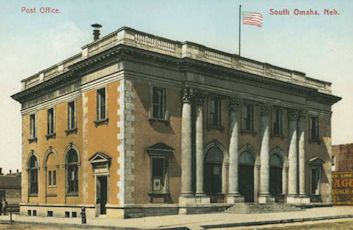 Omaha was its own town. South Omaha was annexed by Omaha in 1915. On a side note, I always like it when I can connect unrelated items in Nebraska Memories to each other. In this case, there is a postcard of the South Omaha Post Office in the collection. The post office building was completed in 1899 so it’s possible that the postcard of Hanson’s Café passed through that building. The post office building is still being used as a post office today.
Omaha was its own town. South Omaha was annexed by Omaha in 1915. On a side note, I always like it when I can connect unrelated items in Nebraska Memories to each other. In this case, there is a postcard of the South Omaha Post Office in the collection. The post office building was completed in 1899 so it’s possible that the postcard of Hanson’s Café passed through that building. The post office building is still being used as a post office today.
 Some postmarks contain more information. The image on the left is the postmark on the back of the Omaha Boulevard, South West, Omaha, Nebraska card. Do you see where it says Union Depot Postal Site? I think the last word is “site” it is hard to read. I’m assuming that means the card was cancelled at the Union Depot.
Some postmarks contain more information. The image on the left is the postmark on the back of the Omaha Boulevard, South West, Omaha, Nebraska card. Do you see where it says Union Depot Postal Site? I think the last word is “site” it is hard to read. I’m assuming that means the card was cancelled at the Union Depot.
 This postcard of the state capitol at night was postmarked On Mary 14, 1912 at Station C in Lincoln. I know Station C doesn’t mean a lot on its own but I checked a few of my favorite research sources and found just what I was looking for in the 1918 Lincoln City Directory.
This postcard of the state capitol at night was postmarked On Mary 14, 1912 at Station C in Lincoln. I know Station C doesn’t mean a lot on its own but I checked a few of my favorite research sources and found just what I was looking for in the 1918 Lincoln City Directory. 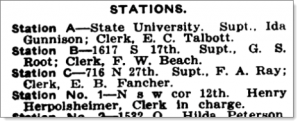 Page 49 in the book provides a wealth of information about the post offices in Lincoln. The book provides the location of the main Lincoln post office plus the locations of stations A, B, C and 1-7. According to this information, Station C was located at 716 N 27th street. That’s about at the corner of 27th and Vine Street.
Page 49 in the book provides a wealth of information about the post offices in Lincoln. The book provides the location of the main Lincoln post office plus the locations of stations A, B, C and 1-7. According to this information, Station C was located at 716 N 27th street. That’s about at the corner of 27th and Vine Street.
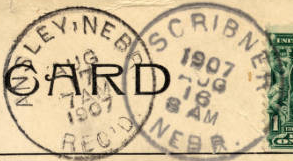 Another interesting postmark I ran across was the received postmark. It appears that some items were marked as received when they reached their destination. I was curious to see how long it took a postcard to reach its destination in the late 1900’s so
Another interesting postmark I ran across was the received postmark. It appears that some items were marked as received when they reached their destination. I was curious to see how long it took a postcard to reach its destination in the late 1900’s so 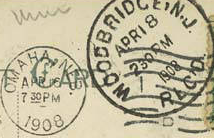 I put together the chart below. It shows the date, time and location of both postmarks. For the last column, I wanted a general idea of the distance between the two locations so I used a map to find the shortest distance. I was surprised to see how quickly the cards reached their destination. (Click on the town names listed in the Mailed From column to see the postcards.)
I put together the chart below. It shows the date, time and location of both postmarks. For the last column, I wanted a general idea of the distance between the two locations so I used a map to find the shortest distance. I was surprised to see how quickly the cards reached their destination. (Click on the town names listed in the Mailed From column to see the postcards.)
| Mailed From | Postmark Sent | Mailed To | Postmark Received | Miles between |
| Hastings | Feb 24, 1908 at midnight | Kearney | Feb 24, 1908 at 6:00 AM | 57 |
| Lincoln | Feb 21, 1908 at 8:00 AM | Hastings | Feb 21, 1908 at 4:00 PM | 108 |
| Lincoln | Sep 10, 1907 at 8:00 AM | Moulton, IA | Sep 11, 1907 at 7:00 AM | 282 |
| Omaha | Feb 12, 1907 at 4:30 PM | Corning, IA | Feb 13, 1907 at 7:00 AM | 80 |
| Omaha | May 13, 1905 at 7:00 AM | Union City, MI | May 15, 1905 at 8:00 AM | 623 |
| Omaha | Apr 16, 1908 at 7:30 PM | Woodbridge, NJ | April 18, 1908 at 2:30 PM | 1,251 |
| Scottsbluff | Jun 23, 1906 at 5:00 PM | Omaha | Jun 24, 1906 at 7:00 AM | 451 |
| Scribner | Aug 16, 1907 at 8:00 AM | Ansley | Aug 17, 1907 at 7:00 AM | 170 |
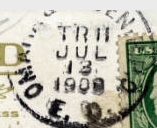 The last type of postmark I want to highlight is the RPO postmark. RPO stands for Railway Post Office. I didn’t know anything about RPO until I started doing some research for this blog post. I learned that mail clerks road on the train and sorted the mail as they went and it was a dangerous job. If you would like to know more about railway mail service, the Smithsonian provides a great history of the service.
The last type of postmark I want to highlight is the RPO postmark. RPO stands for Railway Post Office. I didn’t know anything about RPO until I started doing some research for this blog post. I learned that mail clerks road on the train and sorted the mail as they went and it was a dangerous job. If you would like to know more about railway mail service, the Smithsonian provides a great history of the service.
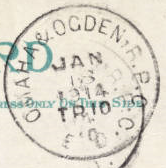 There are two postcards in Nebraska Memories that have RPO postmarks. They are both for the Omaha & Ogden (Utah) route. The postmarks contain the date and time information along with one unique piece of information. The postmarks also include the train number. An article in the Jan 1909 edition of the Omaha Bee
There are two postcards in Nebraska Memories that have RPO postmarks. They are both for the Omaha & Ogden (Utah) route. The postmarks contain the date and time information along with one unique piece of information. The postmarks also include the train number. An article in the Jan 1909 edition of the Omaha Bee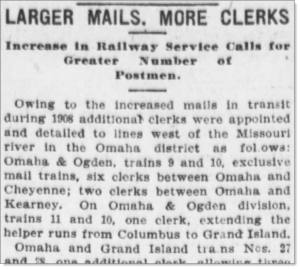 talks about how the increase in mail required more clerks on the railroad lines west of the Missouri river. To the left is first paragraph of the article that talks about the Omaha & Ogden route.
talks about how the increase in mail required more clerks on the railroad lines west of the Missouri river. To the left is first paragraph of the article that talks about the Omaha & Ogden route.
I hope you enjoyed learning about a few of the different postmarks. Visit Nebraska Memories to search for or browse through many more historical images digitized from photographs, negatives, postcards, maps, lantern slides, books and other materials.
Nebraska Memories is a cooperative project to digitize Nebraska-related historical and cultural heritage materials and make them available to researchers of all ages via the Internet. Nebraska Memories is brought to you by the Nebraska Library Commission. If your institution is interested in participating in Nebraska Memories, see http://nlc.nebraska.gov/nebraskamemories/participation.aspx for more information, contact Devra Dragos, Technology & Access Services Director.
Posted in Nebraska Memories
Tagged digitized, historical images, History, mail, Nebraska, Nebraska Memories, Postcard, Postmarks
2 Comments
Throwback Thursday: 1951 Halloween Party
NLC is getting all geared up for Halloween with this week’s #ThrowbackThursday! Photograph of children and teenagers at a Halloween party for the Nebraska Children’s Home Society in 1951.
Photo provided by the Nebraska Children’s Home Society collection located in Nebraska Memories.
Nebraska Memories is a cooperative project to digitize Nebraska-related historical and cultural heritage materials and make them available to researchers of all ages via the Internet. Nebraska Memories is brought to you by the Nebraska Library Commission. If your institution is interested in participating in Nebraska Memories, see http://nlc.nebraska.gov/nebraskamemories/participation.aspx for more information.
What Goes Around
Some people say change is inevitable, but how much have things really changed over the past 100 years?
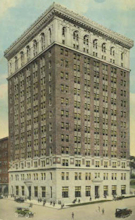 In 1917, the Nebraska Telephone Co. Building at left was completed in Omaha with a “modern telephone exchange” (Omaha Public Library Collection). There were over 6,000 independent telephone companies in the United States at that time with a fair number in Nebraska. Over the years many of those companies merged or were bought out. Today with the cell phone technology, different service providers, who buy out and/or merge with each other regularly, are again working to provide a new “telephone exchange” by expanding cell phone service to the more rural areas of Nebraska.
In 1917, the Nebraska Telephone Co. Building at left was completed in Omaha with a “modern telephone exchange” (Omaha Public Library Collection). There were over 6,000 independent telephone companies in the United States at that time with a fair number in Nebraska. Over the years many of those companies merged or were bought out. Today with the cell phone technology, different service providers, who buy out and/or merge with each other regularly, are again working to provide a new “telephone exchange” by expanding cell phone service to the more rural areas of Nebraska.
 Transportation was in flux in 1917. While horse-drawn vehicles were still in use in some rural areas, motorized vehicles were taking over–both gas and electric. This brought about the building of automobile dealerships, gas stations, garages, solid-surface roads, and more. The Osborne Garage in Sidney at right was one of many such businesses being built in Nebraska (Cheyenne County Historical Society and Museum Collection). Mechanics today use computers to tune-up cars and trucks, but the basic need is still there for new tires, oil changes, etc. Now new dealerships and their garages are being built on the outskirts of town. And while gas cars won out for a number of decades, electric cars are making a comeback and bringing about the construction of re-charging stations. And who doesn’t run into road construction–or the need for it–on a regular basis?
Transportation was in flux in 1917. While horse-drawn vehicles were still in use in some rural areas, motorized vehicles were taking over–both gas and electric. This brought about the building of automobile dealerships, gas stations, garages, solid-surface roads, and more. The Osborne Garage in Sidney at right was one of many such businesses being built in Nebraska (Cheyenne County Historical Society and Museum Collection). Mechanics today use computers to tune-up cars and trucks, but the basic need is still there for new tires, oil changes, etc. Now new dealerships and their garages are being built on the outskirts of town. And while gas cars won out for a number of decades, electric cars are making a comeback and bringing about the construction of re-charging stations. And who doesn’t run into road construction–or the need for it–on a regular basis?
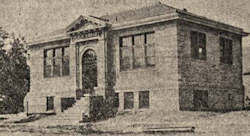 The population growth in early twentieth-century Nebraska brought a demand for amenities such as public libraries. At least 72 Nebraska towns erected new public library buildings between 1900 and 1920. 1917 alone saw the construction of at least nine public library buildings, two of which are still used as libraries: Cordelia B. Preston Memorial Library in Orleans and Arcadia Public Library at left (Nebraska Library Commission Collection). Other libraries have had to move on from old buildings to new buildings as technology has brought demands for different services. In 2017, Blair Public Library and Scribner Public Library both celebrated grand openings of their new facilities.
The population growth in early twentieth-century Nebraska brought a demand for amenities such as public libraries. At least 72 Nebraska towns erected new public library buildings between 1900 and 1920. 1917 alone saw the construction of at least nine public library buildings, two of which are still used as libraries: Cordelia B. Preston Memorial Library in Orleans and Arcadia Public Library at left (Nebraska Library Commission Collection). Other libraries have had to move on from old buildings to new buildings as technology has brought demands for different services. In 2017, Blair Public Library and Scribner Public Library both celebrated grand openings of their new facilities.
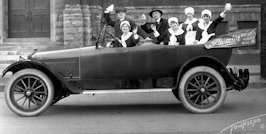 Live entertainment was popular in 1917 as it is today. In the Boileau Chautauqua Company photograph at right cast members in costume pose in a car. (Townsend Studio Collection). As the banner on the rear promotes the model of the car, perhaps this is an early example of promoting products for corporate sponsorship. While many people still traveled by train in 1917, touring cars (open cars that could carry five or more passengers a long distance) would become popular. A car allowed more flexibility in timetables and destinations. Today many entertainers move on to their next venue in tour buses.
Live entertainment was popular in 1917 as it is today. In the Boileau Chautauqua Company photograph at right cast members in costume pose in a car. (Townsend Studio Collection). As the banner on the rear promotes the model of the car, perhaps this is an early example of promoting products for corporate sponsorship. While many people still traveled by train in 1917, touring cars (open cars that could carry five or more passengers a long distance) would become popular. A car allowed more flexibility in timetables and destinations. Today many entertainers move on to their next venue in tour buses.
So visit Nebraska Memories and see what old things or concepts are new again among the many historical images digitized from photographs, negatives, postcards, maps, lantern slides, books and other materials.
Nebraska Memories is a cooperative project to digitize Nebraska-related historical and cultural heritage materials and make them available to researchers of all ages via the Internet. Nebraska Memories is brought to you by the Nebraska Library Commission. If your institution is interested in participating in Nebraska Memories, see http://nlc.nebraska.gov/nebraskamemories/participation.aspx for more information, contact Devra Dragos, Technology & Access Services Director.
Posted in Nebraska Memories
Leave a comment
The Undivided Back
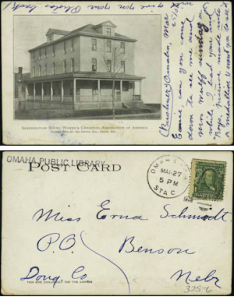 When looking at old postcards in Nebraska Memories have you noticed that some of them have writing on the front of the card or that there is a lot of white space around the picture on the postcard? This may be because in the early days people were not allowed to write a message on the back of the postcard next to the address.
When looking at old postcards in Nebraska Memories have you noticed that some of them have writing on the front of the card or that there is a lot of white space around the picture on the postcard? This may be because in the early days people were not allowed to write a message on the back of the postcard next to the address.
The Smithsonian Institution provides a nice history of postcards starting in 1861 when the US Congress passed an act that allowed privately printed cards to be sent in the mail.
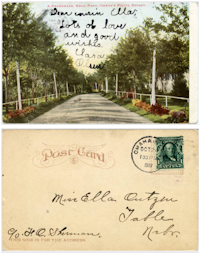 Later legislation passed in 1873 allowed the government to produce postcards with a message on one side and an address on the other side. These government postcards could be mailed for 1¢ however privately created postcards cost 2¢ to mail. In 1898 the prices were changeed so all postcards required just a 1¢ stamp. Other laws were enacted between 1898 and 1906 that changed the requirements on what information must be printed on the back of a postcard however; people were still not allowed to write a message on the back of the card next to the address.
Later legislation passed in 1873 allowed the government to produce postcards with a message on one side and an address on the other side. These government postcards could be mailed for 1¢ however privately created postcards cost 2¢ to mail. In 1898 the prices were changeed so all postcards required just a 1¢ stamp. Other laws were enacted between 1898 and 1906 that changed the requirements on what information must be printed on the back of a postcard however; people were still not allowed to write a message on the back of the card next to the address.
Americans were finally allowed to write on the backside of the postcards in 1907. According to the 1906 Post-Office Department Annual Reports for the Fiscal Year ended June 30, 1906, this change came about after the meeting of the Universal Postal Union that took place in Rome. After a bit of research, I learned that Universal Postal Union (UPU) is the international organization that sets the rules for international mail exchange. The UPU was established in 1874.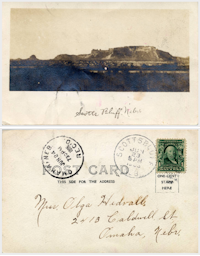
The change to allow writing on both sides of the card came about because of public request. Folks did not want to write a message on or next to the images on the front side of the cards. European countries were the first to make this change. Starting on October 31, 1906 the US Post Office started allowing postcards mailed from foreign countries to be delivered in the US with writing on the back. On March 1, 1907, the US Post Office allowed postcards mailed domestically to have written messages on the left side of the card next to the address. If you read the original text in the 1906 US Post Office report, you will see that they refer to the side of the postcard that contains the address to be the front of the postcard.
This period between 1901 and 1907, when folks were not allowed to write on the back of the postcard has become known as the Undivided Back Period. All of the postcards included in this post are from Nebraska Memories and examples from the Undivided Back Period. Looking at the back of these postcards, you will see that all of them contain a printed message that makes it clear that the only thing that can be put on the back of the postcard is the address.
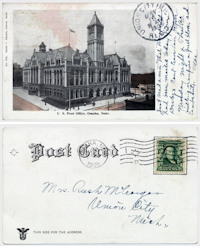 Visit Nebraska Memories to search for or browse through many more historical images digitized from photographs, negatives, postcards, maps, lantern slides, books and other materials.
Visit Nebraska Memories to search for or browse through many more historical images digitized from photographs, negatives, postcards, maps, lantern slides, books and other materials.
Nebraska Memories is a cooperative project to digitize Nebraska-related historical and cultural heritage materials and make them available to researchers of all ages via the Internet. Nebraska Memories is brought to you by the Nebraska Library Commission. If your institution is interested in participating in Nebraska Memories, see http://nlc.nebraska.gov/nebraskamemories/participation.aspx for more information, contact Devra Dragos, Technology & Access Services Director.
Caring for the Children
Nebraska Memories Archive: Nebraska Orthopedic Hospital
If you lived in a small rural town in the early 1900s, would you expect your local physician to be able to handle a case of Pott’s disease or a cleft palate? In 1905, the Nebraska Legislature believed children with deformities needed extra help and funded what was first known as the Nebraska State Hospital for Crippled, Ruptured and Deformed Children but soon became the Nebraska Orthopedic Hospital. As reported in the Biennial Report of The Nebraska Orthopedic Hospital for the period ending November 30, 1908, the hospital was established “by act of the Legislature … to provide hospital care for the crippled and deformed of this state who by such hospital treatment might be converted from wards of the municipalities or counties from which they came into individuals who in one way or another might become self-sustaining and independent.” As further biennial reports show, the patients were not all children.
Half of the $10,000 budget for the first year was used to remodel the boys’ dormitory on the campus of the Home for the Friendless. The hospital then opened for patients on October 1, 1905. The first year’s report to the governor, while describing its work with 106 patients, outlines the problems of not having a newly built hospital with all the facilities needed to treat and rehabilitate patients.
In 1908, the Lincoln City Directory lists the hospital’s address as 2129 S. 11th Street and directs visitors to take the S. 10th Street streetcar. No matter how patients arrived, they came from all parts of the state, including Sioux County in the farthest northwest corner.
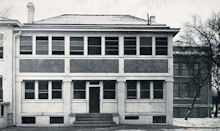 Over the next few years, the hospital took over additional buildings on the campus and extensions to the buildings were added, like the sleeping porches at right. Fresh air was considered important in recuperation, and without air conditioning, sleeping quarters with as many windows as possible made things more comfortable. As a number of the patients stayed for an extended period of time, various services needed to be provided such as a teacher to school classes and a gymnasium for physical training.
Over the next few years, the hospital took over additional buildings on the campus and extensions to the buildings were added, like the sleeping porches at right. Fresh air was considered important in recuperation, and without air conditioning, sleeping quarters with as many windows as possible made things more comfortable. As a number of the patients stayed for an extended period of time, various services needed to be provided such as a teacher to school classes and a gymnasium for physical training.
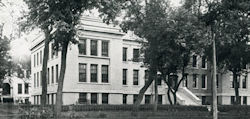 By 1915, the hospital had its new building (shown at left) at 1041 South Street, a block away from the old one. According to the biennial report of 1916, this building included “new and modern office rooms, library, reception rooms, dining rooms, school rooms, laboratory, surgical department complete, and three wards with a capacity of forty beds. … the different floors communicate by inclines instead of stairways.” But the report also includes recommendations for further updates of the other buildings.
By 1915, the hospital had its new building (shown at left) at 1041 South Street, a block away from the old one. According to the biennial report of 1916, this building included “new and modern office rooms, library, reception rooms, dining rooms, school rooms, laboratory, surgical department complete, and three wards with a capacity of forty beds. … the different floors communicate by inclines instead of stairways.” But the report also includes recommendations for further updates of the other buildings.
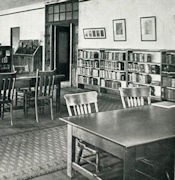 The State Library Commission was in charge of furnishing the new library at right, as well as stocking it with materials and supervising it. The library served both patients and employees. Students of the nursing school established at the hospital would have found many useful materials here. The school started in 1906, provided two years of training, following which some graduates went on to study for higher degrees. The students provided extra help with nursing duties and probably cut down on salaries that would have been paid to full-time staff.
The State Library Commission was in charge of furnishing the new library at right, as well as stocking it with materials and supervising it. The library served both patients and employees. Students of the nursing school established at the hospital would have found many useful materials here. The school started in 1906, provided two years of training, following which some graduates went on to study for higher degrees. The students provided extra help with nursing duties and probably cut down on salaries that would have been paid to full-time staff.
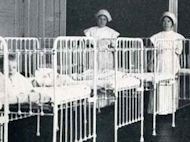 The children’s ward at left looks rather spartan but was probably very easy to keep clean. Patients didn’t necessarily stay in the wards all the time. In addition to fresh air, the doctor’s also promoted the benefits of sunshine and activity. Vocational training was encouraged for those who could manage it. Visitors were permitted for a few hours every day. And the entertainment was provided, especially in later years. For example, in the 1950s, Jock Mahoney, an actor, stuntman, and former stepfather of actress Sally Field, visited with patients in the hospital.
The children’s ward at left looks rather spartan but was probably very easy to keep clean. Patients didn’t necessarily stay in the wards all the time. In addition to fresh air, the doctor’s also promoted the benefits of sunshine and activity. Vocational training was encouraged for those who could manage it. Visitors were permitted for a few hours every day. And the entertainment was provided, especially in later years. For example, in the 1950s, Jock Mahoney, an actor, stuntman, and former stepfather of actress Sally Field, visited with patients in the hospital.
The hospital continued to add buildings and make improvements over the years. In the 1920s a cottage was built for the superintendent, and a separate dormitory was built for the nurses. A dental department was added and the physiotherapy equipment expanded in the 1930s.
Although the hospital admitted and treated 1,587 patients in the 1970-1971 biennium, the 1971 Legislature decided to accept the recommendation of a 1968 study which said the hospital should be closed.
Visit Nebraska Memories to search for or browse through many more historical images digitized from photographs, negatives, postcards, maps, lantern slides, books and other materials.
Nebraska Memories is a cooperative project to digitize Nebraska-related historical and cultural heritage materials and make them available to researchers of all ages via the Internet. Nebraska Memories is brought to you by the Nebraska Library Commission. If your institution is interested in participating in Nebraska Memories, see http://nlc.nebraska.gov/nebraskamemories/participation.aspx for more information, contact Devra Dragos, Technology & Access Services Director.
Posted in Nebraska Memories
Tagged Archive, free, Nebraska, Nebraska Memories, Nebraska Orthopedic Hospital, NLC Blog
Leave a comment
Nebraska Hall of Fame Newest Inductee Selected
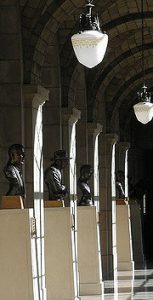 On August 2, 2017, the Nebraska Hall of Fame Commission selected Thomas Rogers Kimball, a Nebraska architect, as its newest inductee. The Nebraska Hall of Fame was established in 1961 to recognize prominent Nebraskans. As of 1998, only one person is added to the Hall of Fame every five years. Busts of Hall of Fame members are placed in the Nebraska State Capitol. An induction ceremony for Kimball will be planned in 2019.
On August 2, 2017, the Nebraska Hall of Fame Commission selected Thomas Rogers Kimball, a Nebraska architect, as its newest inductee. The Nebraska Hall of Fame was established in 1961 to recognize prominent Nebraskans. As of 1998, only one person is added to the Hall of Fame every five years. Busts of Hall of Fame members are placed in the Nebraska State Capitol. An induction ceremony for Kimball will be planned in 2019.
Thomas Rogers Kimball was born in Ohio in 1862 but moved to Omaha with his family when he was in his early teens. Kimball studied at the University of Nebraska then went on to study architecture at the Massachusetts Institute of Technology. In 1891, Kimball returned to Omaha and opened an office.
Kimball designed numerous buildings, many of which are still in use today. In Nebraska Memories, there are images of fourteen different buildings that Thomas Rogers Kimball designed. Here are few of the buildings you may recognize.
In addition to designing buildings, Kimball also served as an architectural adviser on numerous projects both in Nebraska and in other states. The two most notable projects in Nebraska included the Trans-Mississippi Exposition and the State Capitol. Rogers along with C. Howard Walker were co-architects-in-chief of the Trans-Mississippi Exposition and designed a few of the buildings. Kimball also served as an architectural advisor for Nebraska State Capitol Commission. He was involved in organizing the competition that lead to the design of the current Capitol.
Thomas Rogers Kimball died in September 1934 just after the Nebraska State Capitol was completed.
Visit Nebraska Memories to search for or browse through many more historical images digitized from photographs, negatives, postcards, maps, lantern slides, books and other materials.
Nebraska Memories is a cooperative project to digitize Nebraska-related historical and cultural heritage materials and make them available to researchers of all ages via the Internet. Nebraska Memories is brought to you by the Nebraska Library Commission. If your institution is interested in participating in Nebraska Memories, see http://nlc.nebraska.gov/nebraskamemories/participation.aspx for more information, contact Devra Dragos, Technology & Access Services Director.
Posted in Nebraska Memories, Technology
Leave a comment
Over There
The Great War (later known as World War I) was the first large multi-country conflict in which United States forces fought. Although the U.S. took an non-intervention stance when the war started in 1914, Congress declared war and joined the Allies in April 1917 after Germany returned to torpedoing U.S. ships and offered Mexico financing to attack the U.S. on its southern border. While it took almost a year for the American Expeditionary Forces (AEF) to arrive in France in great numbers, AEF was established one hundred years ago this month under the command of General John J. “Black Jack” Pershing.
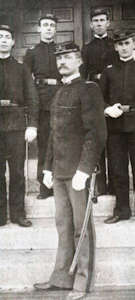 Pershing started his military career at forts in the western
Pershing started his military career at forts in the western 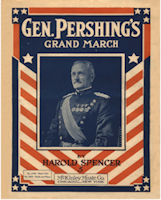 territories after graduating from West Point in 1886. After fighting in several Indian campaigns, he was assigned to the University of Nebraska in Lincoln as a professor for military science and tactics and Commandant of Cadets (at left Pershing with some of his staff at the University, Townsend Studio Collection) . While there, Pershing formed a drill company which was later renamed the Pershing Rifles. Pershing attended the UNL law school and took his degree in 1893. Pershing is remembered in the naming of several buildings in Lincoln, including an elementary school and an event facility. And while they may have been singing Gershwin’s “Over There” on Broadway, Fall City’s own Harold Spencer honored Pershing with “General Pershing’s Grand March” (above right, Polley Music Library Collection).
territories after graduating from West Point in 1886. After fighting in several Indian campaigns, he was assigned to the University of Nebraska in Lincoln as a professor for military science and tactics and Commandant of Cadets (at left Pershing with some of his staff at the University, Townsend Studio Collection) . While there, Pershing formed a drill company which was later renamed the Pershing Rifles. Pershing attended the UNL law school and took his degree in 1893. Pershing is remembered in the naming of several buildings in Lincoln, including an elementary school and an event facility. And while they may have been singing Gershwin’s “Over There” on Broadway, Fall City’s own Harold Spencer honored Pershing with “General Pershing’s Grand March” (above right, Polley Music Library Collection).
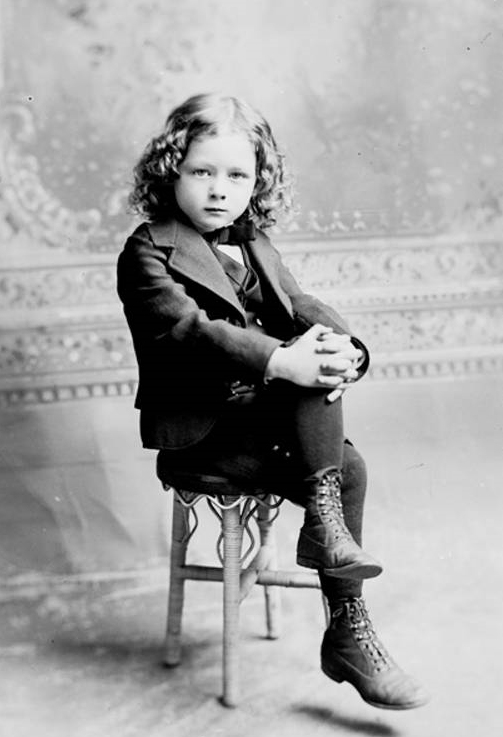 Young men such as Marvin Murphy (above, Butler County Gallery) volunteered from towns across Nebraska joined the fight. Of course this photo was taken a few years before Marvin served in France and Germany at the age of twenty-two. As did many Nebraska veterans, Marvin returned to Nebraska, raised his family, worked in the family business, and served in a civic capacity.
Young men such as Marvin Murphy (above, Butler County Gallery) volunteered from towns across Nebraska joined the fight. Of course this photo was taken a few years before Marvin served in France and Germany at the age of twenty-two. As did many Nebraska veterans, Marvin returned to Nebraska, raised his family, worked in the family business, and served in a civic capacity.
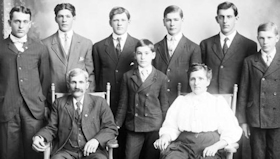 Some families saw more than one son off to war. The two youngest sons of Joseph Welty both served in the war (at left, Butler County Gallery). Herbert would also have been twenty-two and Paul twenty-six. Three of the sons already had military experience, serving with the Nebraska National Guard during the Mexican insurrection in 1916. And, as happens in small towns, relativ
Some families saw more than one son off to war. The two youngest sons of Joseph Welty both served in the war (at left, Butler County Gallery). Herbert would also have been twenty-two and Paul twenty-six. Three of the sons already had military experience, serving with the Nebraska National Guard during the Mexican insurrection in 1916. And, as happens in small towns, relativ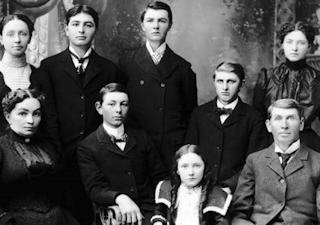 es through marriage also served in the military. Louis Welty, the second oldest son, married Mary Rosetta Delaney (standing at far right in the photo at right) whose younger brothers Charles (seated next to their mother) and Michael (seated next to Mary) were two of the older participants in the Great War. Charles was thirty-five in 1918 and Michael thirty-eight.
es through marriage also served in the military. Louis Welty, the second oldest son, married Mary Rosetta Delaney (standing at far right in the photo at right) whose younger brothers Charles (seated next to their mother) and Michael (seated next to Mary) were two of the older participants in the Great War. Charles was thirty-five in 1918 and Michael thirty-eight.
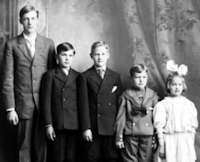
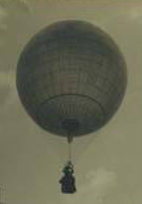 Not all the volunteers served in the army or overseas during the war. From the George Schweser family (at left, Butler County Gallery), Harold, the oldest served as a lieutenant in the Balloon Service in Oklahoma. Closer to home, at Fort Omaha, was the Balloon School (at right, Omaha Public Library Collection) which taught about 800 men for the Signal Corp in the war. Carl, the second oldest Schweser, served as an airplane mechanic at Camp Taylor in Alabama. And, Robert, the third in line, served in the navy.
Not all the volunteers served in the army or overseas during the war. From the George Schweser family (at left, Butler County Gallery), Harold, the oldest served as a lieutenant in the Balloon Service in Oklahoma. Closer to home, at Fort Omaha, was the Balloon School (at right, Omaha Public Library Collection) which taught about 800 men for the Signal Corp in the war. Carl, the second oldest Schweser, served as an airplane mechanic at Camp Taylor in Alabama. And, Robert, the third in line, served in the navy.
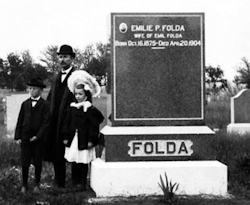 Not all those who served made it back home from the Great War. Some died in the training camps from measles, flu, dysentary, or other diseases. Some died when their ships were sunk on the way to Europe and many more, like Albin Folda (at right with his father and sister at his mother’s grave, Butler County Gallery) died on the battlefield. Albin’s grandparents had emigrated from Bohemia, looking for a better life in the United States. They found it on a Nebraska farm they homesteaded fifty years before their twenty-four year old grandson died in France.
Not all those who served made it back home from the Great War. Some died in the training camps from measles, flu, dysentary, or other diseases. Some died when their ships were sunk on the way to Europe and many more, like Albin Folda (at right with his father and sister at his mother’s grave, Butler County Gallery) died on the battlefield. Albin’s grandparents had emigrated from Bohemia, looking for a better life in the United States. They found it on a Nebraska farm they homesteaded fifty years before their twenty-four year old grandson died in France.
Visit Nebraska Memories to search for or browse through many more historical images digitized from photographs, negatives, postcards, maps, lantern slides, books and other materials.
Nebraska Memories is a cooperative project to digitize Nebraska-related historical and cultural heritage materials and make them available to researchers of all ages via the Internet. Nebraska Memories is brought to you by the Nebraska Library Commission. If your institution is interested in participating in Nebraska Memories, see http://nlc.nebraska.gov/nebraskamemories/participation.aspx for more information, contact Devra Dragos, Technology & Access Services Director.
Posted in Nebraska Memories
Leave a comment
Preserving the Past
Your library has boxes and boxes of old photographs, documents and who knows what else. They’re old. They’re dusty. Some are labeled. Some aren’t. They’ve been in those boxes for years. You don’t know what to do with them. You’d like find a way to preserve them, preferably in digital form, but this type of project seems overwhelming. Where do you start? How do you get started?
The good news! You don’t have to go at it alone. If your town is like the one I grew up in, there’s always someone or some group looking for a project. In fact, your local historical society or museum would make a fantastic partner. Chances are, they have the resources to help you identify those photographs. Also, projects are easier (and more fun) when you share the workload. 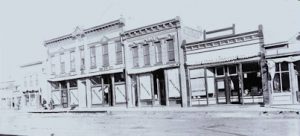
But wait! There’s more good news! The Nebraska Library Commission manages Nebraska Memories, an online archive of digital Nebraska-related historical and cultural heritage materials. Funded through a combination of funding from the Institute of Museum and Library Services and the Nebraska Library Commission, Nebraska Memories contains images digitized from photographs, negatives, postcards, maps, lantern slides, books and other materials. Working either independently or with a partner, Nebraska cultural institutions have digitized and contributed more than 5,000 items to Nebraska Memories.
Libraries and other institutions that have partnered to digitize and upload materials to Nebraska Memories include the Antelope County Historical Society and Tilden’s Raymond A. Whitwer Memorial Library; the Crawford Historical Society and Museum and the Crawford Public Library and the High Plains Historical Society and Museum and the McCook Public Library.
I hope after reading this post, you’ll find the prospect of a digital preservation project less overwhelming. Also, you might decide to reach out to a local historical society or museum in order to host a program or two on local history. If your institution is interested in participating in Nebraska Memories, see http://nlc.nebraska.gov/nebraskamemories/participation.aspx for more information, contact Devra Dragos, Technology & Access Services Director.
Posted in Nebraska Memories
1 Comment
A Fresh Perspective
Nebraska Memories contains thousands of images. Many of these images show buildings and street scenes from across the state. When the metadata that accompanies these images includes an address I like to find the location on a map. Finding the location on an online map is easy but since so many of the buildings have changed over the past 100+ years I don’t always find it helpful. When I saw the Library of Congress’s (LOC) announcement that they were providing access to nearly 25,000 Sanborn Fire Insurance Maps I was thrilled. At this time, the maps from sixteen states are available. Lucky for us one of those states in Nebraska. Currently all of the maps available were published prior to 1900.
If you’ve never seen a Sanborn Fire Insurance Map before they may seem a bit odd the first time you look at one. As the name implies, these maps were created for assessing fire insurance liability. On the maps, you will see the outline of buildings along with information about building materials, the number of doors and windows and the amount of hose available. If you need help understanding all of the abbreviations and symbols on the map like I did, I’d suggest you look at the LOC’s About this Collection page.
I started exploring the Sanborn maps by first picking a few photos in Nebraska Memories and then trying to locate them on one of the maps. As I looked at different places on the map, I realized how much information was available. That information combine with seeing how a building related to other structures around it provided me with a fresh perspective of images I’ve viewed multiple times.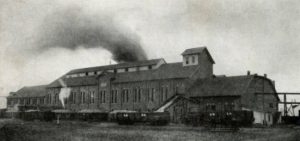
One photo that I selected was the Beet sugar factory, Grand Island, Neb. On the photo, note the two raised sections on the roof and the smoke that is rising from behind the building.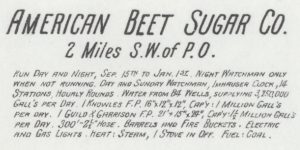 Now let’s look at the 1899 Sanborn Fire Insurance Map from Grand Island, Hall County, Nebraska. I found the American Beet Sugar Co. located on image 18 of the map. Under the name, it says, “2 Miles S. W. of P.O.”. The P.O. as you may have guessed stands for post office. I’ve included a screen shot of paragraph of information available on the map. As you read it, remember these are fire insurance maps.
Now let’s look at the 1899 Sanborn Fire Insurance Map from Grand Island, Hall County, Nebraska. I found the American Beet Sugar Co. located on image 18 of the map. Under the name, it says, “2 Miles S. W. of P.O.”. The P.O. as you may have guessed stands for post office. I’ve included a screen shot of paragraph of information available on the map. As you read it, remember these are fire insurance maps.
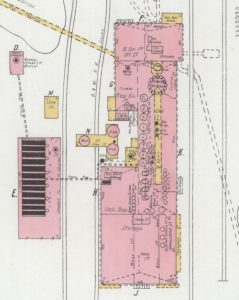 On the drawing of the building, do you see the yellow square with the long yellow rectangle below it? It looks like a yellow i in the middle of the building. If you zoom in on the original map image you can see the words “Tank on R’F.” next to the square and “Vent in R’F” next to the rectangle. Now look to the left of the main building and find the building with the think black lines and small circles. The black lines represent steam boilers. The circles are iron chimneys. The circle with the black dot in the middle is the fire pump. I’m assuming the smoke or steam that we see in the picture is coming from this building. Taking these three pieces of information and comparing it to the photo, I would guess this picture shows the east side of the factory. Looking at the map, you will see other features of the factory such as the “underground sluice” that connects the beet shed to the main building and the “Molasses Reservoir (underground) Wood Cover”. These maps were drawn to scale so we can see that the reservoir is huge. Other areas I noticed include washers, brushes, slicing machine, granulator, press room and lime slackers.
On the drawing of the building, do you see the yellow square with the long yellow rectangle below it? It looks like a yellow i in the middle of the building. If you zoom in on the original map image you can see the words “Tank on R’F.” next to the square and “Vent in R’F” next to the rectangle. Now look to the left of the main building and find the building with the think black lines and small circles. The black lines represent steam boilers. The circles are iron chimneys. The circle with the black dot in the middle is the fire pump. I’m assuming the smoke or steam that we see in the picture is coming from this building. Taking these three pieces of information and comparing it to the photo, I would guess this picture shows the east side of the factory. Looking at the map, you will see other features of the factory such as the “underground sluice” that connects the beet shed to the main building and the “Molasses Reservoir (underground) Wood Cover”. These maps were drawn to scale so we can see that the reservoir is huge. Other areas I noticed include washers, brushes, slicing machine, granulator, press room and lime slackers.
Next, I located the Union College campus on image 47 of the 1891 Sanborn Fire Insurance Map from Lincoln, Lancaster County, Nebraska. The Union College, Ella Johnson Crandall Memorial Library has a collection of 100+ images in Nebraska Memories so I knew there were many photos available.
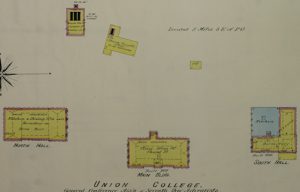 When you look at this map or any of the Sanborn maps, make sure you look for the compass rose on the map and locate north. At first I had assumed the top of the map was north but quickly learned that is not always true. The location of north can even change from one image to the next. If you look at the full version of the Union College map, you will see that north is to the left.
When you look at this map or any of the Sanborn maps, make sure you look for the compass rose on the map and locate north. At first I had assumed the top of the map was north but quickly learned that is not always true. The location of north can even change from one image to the next. If you look at the full version of the Union College map, you will see that north is to the left.
The map shows five buildings located on campus. There are images of the three largest building in Nebraska Memories. Because these three buildings have been torn down, this map gives us a better perspective on exactly where they were located in relationship to each other. Remember that these maps are drawn to scale.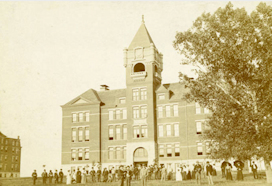
- Main Building or the Administration Building – It is located at the bottom center of the map. It’s noted on the map that it was built in 1891.
- North Hall – This building is located to the left or north of the admin building. A note on the map states that this hall is currently being built.
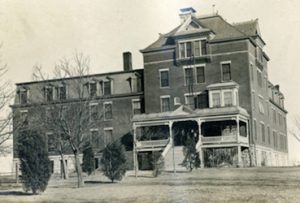
- South Hall – As you can guess, this building is to the right or south of the admin building. The map also notes that this building was built in 1891.
At the top left of the map is a building that is labeled “Bolier R’m 1st Laundry 2d” with the note “To Be Built as Shown”. There are two photos of the Union College laundry building in Nebraska Memories but the photos are from the 1940’s. I don’t have enough information to know if the building in the photo is the same building that is pictured on the map.
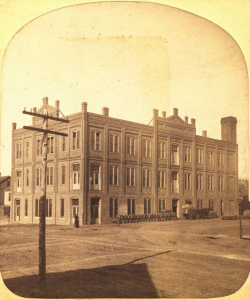 In the 1887 Sanborn Fire Insurance Map from Omaha, Douglas And Sarpy County, Nebraska I located the Garneau Cracker Factory on image 20. This building was located on the northwest corner of 12th and Jackson St. While it was interesting looking at the building and learning that they did the mixing on the 3rd floor and baking on the 2nd what really caught my eye was the last line in the blurb about the building. The line states “1 Doz. Hand Grenades”.
In the 1887 Sanborn Fire Insurance Map from Omaha, Douglas And Sarpy County, Nebraska I located the Garneau Cracker Factory on image 20. This building was located on the northwest corner of 12th and Jackson St. While it was interesting looking at the building and learning that they did the mixing on the 3rd floor and baking on the 2nd what really caught my eye was the last line in the blurb about the building. The line states “1 Doz. Hand Grenades”. 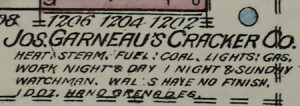 I must admit that I had to stop and think about that one for a few seconds until I remembered that this is a fire insurance map. Those hand grenades were actually fire extinguishers. They were glass containers that were filled with a chemical. You were supposed to throw them at the fire causing the glass to break and releasing the chemical. If you would like to know more about them, I found a newspaper story in the 1884 Pacific Rural Press that includes a picture and description.
I must admit that I had to stop and think about that one for a few seconds until I remembered that this is a fire insurance map. Those hand grenades were actually fire extinguishers. They were glass containers that were filled with a chemical. You were supposed to throw them at the fire causing the glass to break and releasing the chemical. If you would like to know more about them, I found a newspaper story in the 1884 Pacific Rural Press that includes a picture and description.
 I must admit that not all of my attempts to locate buildings on a map were instantly successful. For example, the Cheyenne County Historical Society and Museum has a collection of 77 images in Nebraska Memories that cover a large span of time. In the LOC collection, there are two Sanborn maps for Sidney. One is from 1887 and the other is from 1892. Unfortunately, many of the buildings are not labeled with store names. I was able to find the First Sidney school on image 2 of the 1887 map. It’s located at the corner of 1st St. and Chestnut.
I must admit that not all of my attempts to locate buildings on a map were instantly successful. For example, the Cheyenne County Historical Society and Museum has a collection of 77 images in Nebraska Memories that cover a large span of time. In the LOC collection, there are two Sanborn maps for Sidney. One is from 1887 and the other is from 1892. Unfortunately, many of the buildings are not labeled with store names. I was able to find the First Sidney school on image 2 of the 1887 map. It’s located at the corner of 1st St. and Chestnut.
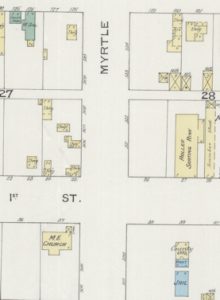 After looking at the Sanborn maps and a current map of Sidney, I’m starting to wonder if the street names have been changed. For example, the note included on the photo of the M.E. Church, Sidney, Nebr. states, “This church, built in 1919, replaced the Methodist Church built in 1884 on the same spot.” The record also states that the church is located at corner of 11th and Jackson Streets and currently is the Sidney Arts Center. I looked at a current map and was able to find the building located across the street from the county court house. On image 2 of the 1887 Sanborn Fire Insurance Map from Sidney, Cheyenne County, Nebraska I located a building labeled “M.E Church” that was also located across the street from a building labeled “County Offs.” These buildings were located at the corner of 1st St. and Myrtle. If I’m correct, that means 1st St. on the Sanborn maps is now Jackson St. and Myrtle is now 11th Ave. With a bit more work, I’m sure it would be possible to match more of the photos with buildings on the map.
After looking at the Sanborn maps and a current map of Sidney, I’m starting to wonder if the street names have been changed. For example, the note included on the photo of the M.E. Church, Sidney, Nebr. states, “This church, built in 1919, replaced the Methodist Church built in 1884 on the same spot.” The record also states that the church is located at corner of 11th and Jackson Streets and currently is the Sidney Arts Center. I looked at a current map and was able to find the building located across the street from the county court house. On image 2 of the 1887 Sanborn Fire Insurance Map from Sidney, Cheyenne County, Nebraska I located a building labeled “M.E Church” that was also located across the street from a building labeled “County Offs.” These buildings were located at the corner of 1st St. and Myrtle. If I’m correct, that means 1st St. on the Sanborn maps is now Jackson St. and Myrtle is now 11th Ave. With a bit more work, I’m sure it would be possible to match more of the photos with buildings on the map.
 I hope you enjoyed viewing these historical images, along with additional information available on the historical Sanborn maps. If you would like to do your own research there are plenty more images in Nebraska Memories and a long list of Nebraska Sanborn maps.
I hope you enjoyed viewing these historical images, along with additional information available on the historical Sanborn maps. If you would like to do your own research there are plenty more images in Nebraska Memories and a long list of Nebraska Sanborn maps.
Nebraska Memories is a cooperative project to digitize Nebraska-related historical and cultural heritage materials and make them available to researchers of all ages via the Internet. Nebraska Memories is brought to you by the Nebraska Library Commission. If your institution is interested in participating in Nebraska Memories, see http://nlc.nebraska.gov/nebraskamemories/participation.aspx for more information, contact Devra Dragos, Technology & Access Services Director.
Posted in Information Resources, Nebraska Memories, Technology
2 Comments
Throwback Thursday: Hotel Fontenelle, Omaha, Nebr.
Posted in General, Nebraska Memories
Leave a comment
Got the Washboard Blues?
Do your dirty clothes and linens seem to multiply overnight? Do you never get to the bottom of your laundry basket? Can you hum the old Hoagy Carmichael tune, “Washboard Blues”? Do you know the F.B. Callahan lyrics? “Keep rubbin’–keep scrubbin’–keep tubbin’–keep drubbin’ ole dirty cloes.” Just imagine not having an electric washing machine and clothes dryer to do most of the back-breaking work for you.
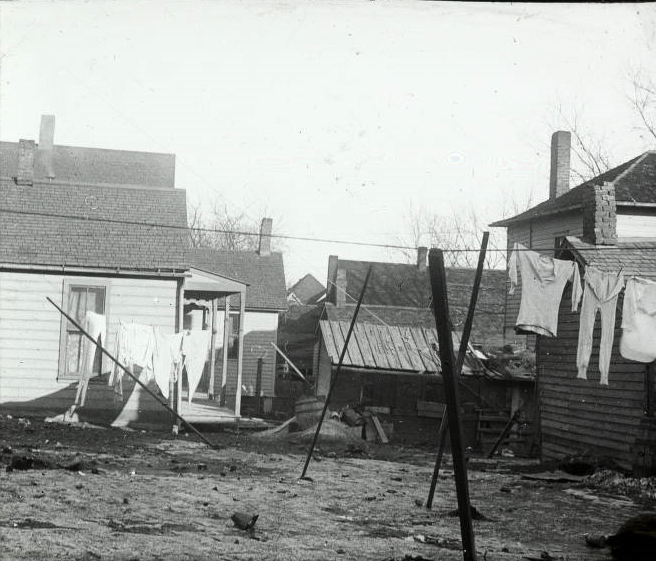 The women who washed the clothes in the picture above probably had to rub, scrub, tub and drub the dirt away as in the song. Most likely using a corrugated washboard and a tub. Note that the backyards in this Omaha neighborhood didn’t have lawns, flower beds, patios, grills, or other ornamentation–just clotheslines. (Omaha Public Library)
The women who washed the clothes in the picture above probably had to rub, scrub, tub and drub the dirt away as in the song. Most likely using a corrugated washboard and a tub. Note that the backyards in this Omaha neighborhood didn’t have lawns, flower beds, patios, grills, or other ornamentation–just clotheslines. (Omaha Public Library)
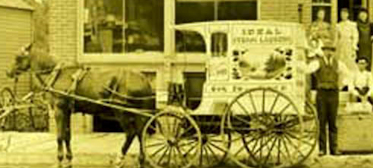 Not all women had to bend over a washboard, some would have had hired girls to do that heavy work while others who could afford it would send out the laundry to be done. Women had been “taking in washing” for centuries. But enterprising businessmen opened full-service laundries in a number of towns across Nebraska in the 1890s and early 1900s. In the photograph (from about 1895) at right, a horse-drawn delivery cart sports the name Ideal Steam Laundry located in Fremont. Women employees stand in front of the door while the man by the cart is probably the owner. (Keene Memorial Library Collection)
Not all women had to bend over a washboard, some would have had hired girls to do that heavy work while others who could afford it would send out the laundry to be done. Women had been “taking in washing” for centuries. But enterprising businessmen opened full-service laundries in a number of towns across Nebraska in the 1890s and early 1900s. In the photograph (from about 1895) at right, a horse-drawn delivery cart sports the name Ideal Steam Laundry located in Fremont. Women employees stand in front of the door while the man by the cart is probably the owner. (Keene Memorial Library Collection)
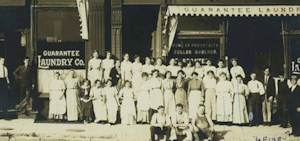 Working in a laundry was acceptable labor for women at that time, as you can see in the postcard at left, most of the Guarantee Laundry Company employees are women. Business must have been booming
Working in a laundry was acceptable labor for women at that time, as you can see in the postcard at left, most of the Guarantee Laundry Company employees are women. Business must have been booming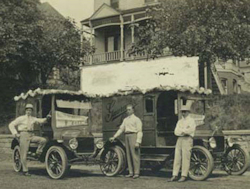 with that number of employees. It also appears that it expanded from one building to two over time, and this was only one of several laundries in Omaha owned by Leonard Heine and his wife in the early 1900s. The photograph at right shows two of the Guarantee’s first motorized delivery trucks in 1916. Note the size of the house in the background; the lady of this house definitely wouldn’t be bending over a washboard. (Omaha Public Library Collection)
with that number of employees. It also appears that it expanded from one building to two over time, and this was only one of several laundries in Omaha owned by Leonard Heine and his wife in the early 1900s. The photograph at right shows two of the Guarantee’s first motorized delivery trucks in 1916. Note the size of the house in the background; the lady of this house definitely wouldn’t be bending over a washboard. (Omaha Public Library Collection)
Lincoln also had its share of laundries (not including dry cleaners or dyers and cleaners). The 1908 Lincoln City Directory listed seven laundries and two “Chinese laundries.” In 1924, the number had increased to ten; 1930 also lists ten, but with a loss of one and a gain of another; the 1951 directory lists the first self-service laundries; and in 1960 the number of full-service laundries had dropped by half while the number of self-service laundries had quadrupled to twenty. People who wanted the convenience of fully automatic washers and dryers but could not afford their own had a place to go, while those who could have afforded to send their laundry out could easily purchase the machines to do their own.
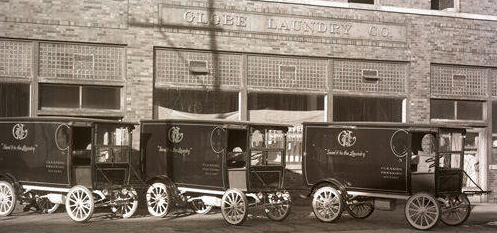 The Globe Laundry was one of the longest lasting Lincoln laundries. Listed in the 1908 City Directory at 330-340 S. 11th Street or the southwest corner of the block. The address by 1930 is reported as 1124 L Street placing it in the south center of the same block, possibly a new building was built in between times. Their building and neat delivery trucks at left, may have been at either location. This entire block was cleared in the 1980s for new development. (Townsend Studio Collection)
The Globe Laundry was one of the longest lasting Lincoln laundries. Listed in the 1908 City Directory at 330-340 S. 11th Street or the southwest corner of the block. The address by 1930 is reported as 1124 L Street placing it in the south center of the same block, possibly a new building was built in between times. Their building and neat delivery trucks at left, may have been at either location. This entire block was cleared in the 1980s for new development. (Townsend Studio Collection)
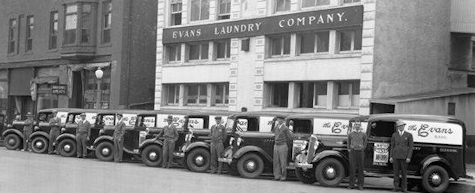 Another long-lived Lincoln business, Evans Laundry Company was located on North 12th Street, close to the University of Nebraska. The 1936 photograph at right shows nine of their delivery trucks parked in front of the southern of their two building with drivers standing at the ready. This block was cleared in 1986 for the building of the Lied Performing Arts Center. (Townsend Studio Collection)
Another long-lived Lincoln business, Evans Laundry Company was located on North 12th Street, close to the University of Nebraska. The 1936 photograph at right shows nine of their delivery trucks parked in front of the southern of their two building with drivers standing at the ready. This block was cleared in 1986 for the building of the Lied Performing Arts Center. (Townsend Studio Collection)
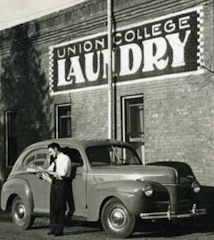 A third long-lived business, Union College Laundry was on the actual campus of Union College in College View, which was annexed by Lincoln in 1929. This laundry opened when the college was established in the 1890s to serve the students; however, it later became a commercial enterprise providing students with part-time jobs to pay their way through school. One employee was Eddie Holweger shown at left reading a newspaper while leaning against a delivery vehicle. (Union College, Ella Johnson Crandall Memorial Library Collection)
A third long-lived business, Union College Laundry was on the actual campus of Union College in College View, which was annexed by Lincoln in 1929. This laundry opened when the college was established in the 1890s to serve the students; however, it later became a commercial enterprise providing students with part-time jobs to pay their way through school. One employee was Eddie Holweger shown at left reading a newspaper while leaning against a delivery vehicle. (Union College, Ella Johnson Crandall Memorial Library Collection)
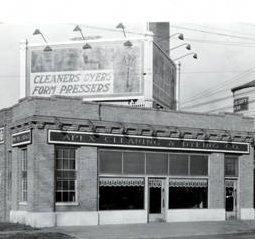 Items needing special care such as furs, hats, tie, and drapes could be taken to cleaners such as Apex Cleaning & Dyeing Company shown at right. While Peter Plamondon had opened the business with offices downtown several years earlier, the new office and main plant building shown at 123 S. 23rd Street was built in 1923. Notice the use of billboard advertising in 1928. This block was also cleared in the 1980s. (Jane Pope Geske Heritage Room of Nebraska Authors Collection)
Items needing special care such as furs, hats, tie, and drapes could be taken to cleaners such as Apex Cleaning & Dyeing Company shown at right. While Peter Plamondon had opened the business with offices downtown several years earlier, the new office and main plant building shown at 123 S. 23rd Street was built in 1923. Notice the use of billboard advertising in 1928. This block was also cleared in the 1980s. (Jane Pope Geske Heritage Room of Nebraska Authors Collection)
Visit Nebraska Memories to search for or browse through many more historical images digitized from photographs, negatives, postcards, maps, lantern slides, books and other materials.
Nebraska Memories is a cooperative project to digitize Nebraska-related historical and cultural heritage materials and make them available to researchers of all ages via the Internet. Nebraska Memories is brought to you by the Nebraska Library Commission. If your institution is interested in participating in Nebraska Memories, see http://nlc.nebraska.gov/nebraskamemories/participation.aspx for more information, contact Devra Dragos, Technology & Access Services Director.
Posted in Nebraska Memories
Leave a comment
Throwback Thursday: Lutheran Hospital, York, Nebraska.
Picture postcard of the Lutheran Hospital, York, Nebraska from the early 1900s. W.F. Gernandt, Architect, Omaha, Nebraska.
Posted in General, Nebraska Memories
Leave a comment
The Boys of Summer
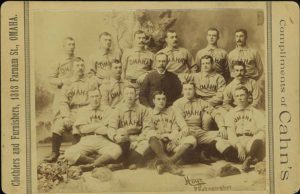 Nothing says summer more than grilled hot dogs, cold lemonade and baseball. Yes, baseball, that most American of past times. Brought to the United States by British immigrants during the eighteenth century, the game as we know it, evolved throughout the nineteenth century. While smaller leagues sprang up around the country, professional leagues didn’t take root until the 1870s.
Nothing says summer more than grilled hot dogs, cold lemonade and baseball. Yes, baseball, that most American of past times. Brought to the United States by British immigrants during the eighteenth century, the game as we know it, evolved throughout the nineteenth century. While smaller leagues sprang up around the country, professional leagues didn’t take root until the 1870s. 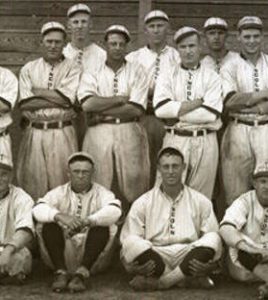
Like other areas, Nebraska colleges and towns fielded baseball teams. In fact, the state has been home to numerous minor league teams. During the first half of the twentieth-century, Lincoln’s Baseball Club was a member of the Western League, which also included a team from Omaha.
To see more photographs of Nebraska baseball teams, visit Nebraska Memories to search for or browse through many more historical images digitized from photographs, negatives, postcards, maps, lantern slides, books and other materials.
Nebraska Memories is a cooperative project to digitize Nebraska-related historical and cultural heritage materials and make them available to researchers of all ages via the Internet. Nebraska Memories is brought to you by the Nebraska Library Commission. If your institution is interested in participating in Nebraska Memories, see http://nlc.nebraska.gov/nebraskamemories/participation.aspxfor more information, contact Devra Dragos, Technology & Access Services Director.
Posted in Nebraska Memories
Leave a comment
Miss Jessie M. Towne, D. O. G.
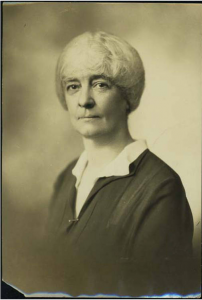 Whenever I see an antique portrait of a person either in an antique store or online, I always wonder who they were. With over 900 portraits in Nebraska Memories, there are plenty of them for me to wonder about. In Nebraska Memories, the amount of information that is provided about each person depends on many factors including where the photo came from and what information was written on or attached to the photo. I thought it might be fun to pick a portrait and see if I could learn more about the person. I looked at a few different portraits and decided to research Jessie M. Towne.
Whenever I see an antique portrait of a person either in an antique store or online, I always wonder who they were. With over 900 portraits in Nebraska Memories, there are plenty of them for me to wonder about. In Nebraska Memories, the amount of information that is provided about each person depends on many factors including where the photo came from and what information was written on or attached to the photo. I thought it might be fun to pick a portrait and see if I could learn more about the person. I looked at a few different portraits and decided to research Jessie M. Towne.
The portrait of Miss Jessie M. Towne is part of Omaha Public Library’s collection. The record for Miss Towne provided me with some great information to start my research. She worked at the Omaha Central High School for over 40 years retiring in 1930. She was a teacher, dean of girls and an assistant principal. I also learned that her father was Solon R. Towne. He was a health inspector and ornithologist.
I started my research by searching the US Census in the MyHeritage Library Edition database. (MyHeritage is a genealogy database that is available to all Nebraska residents at no cost through NebraskAccess.) Here is some of the information I found from looking at multiple censuses.
- Jessie was born in July 1874 in New Hampshire.
- Her parents were Dr. Solon R. Towne and Harriet C. Towne.
- Jessie was the oldest of four children.
- She had one younger brother Robert S. Towne.
- She had two sisters Mary A. Towne and Alice C. Towne.
- In the 1940 Census, both Jessie and Mary were single and living together at 1502 North 54 street in Benson, NE.
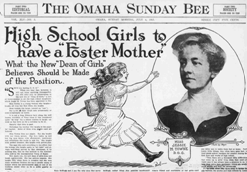 Next, I searched another one of my favorite sites, the Library Of Congress’s Chronicling America: Historic American Newspapers collection. The first article I found was “High School Girls to have a “Foster Mother”.” It appeared in the July 4, 1915 issue of the Omaha Daily Bee and talked about how she was recently appointed D.O.G. D.O.G. stands for Dean of Girls. Miss Towne looks like a series women in both the portrait and the photo that was included in the article. The article, however, describes her as someone who laughs. “Miss Towne does not giggle. But she laughs with her whole person. Her face lights up and her big eyes dance with amusement, merriment and sometimes she rocks to and fro. She laughs with perfect freedom. She laughs with girlish glee.” The article was very amusing to read. I also learned that she had already been teaching at the high school since 1895.
Next, I searched another one of my favorite sites, the Library Of Congress’s Chronicling America: Historic American Newspapers collection. The first article I found was “High School Girls to have a “Foster Mother”.” It appeared in the July 4, 1915 issue of the Omaha Daily Bee and talked about how she was recently appointed D.O.G. D.O.G. stands for Dean of Girls. Miss Towne looks like a series women in both the portrait and the photo that was included in the article. The article, however, describes her as someone who laughs. “Miss Towne does not giggle. But she laughs with her whole person. Her face lights up and her big eyes dance with amusement, merriment and sometimes she rocks to and fro. She laughs with perfect freedom. She laughs with girlish glee.” The article was very amusing to read. I also learned that she had already been teaching at the high school since 1895.
An article that appeared in the June 23, 1915, issue of the Omaha Bee talks about how she was assigned the position of Dean of Students in addition to being the head of the English Literature department. With the addition of the new responsibilities, her salary was increased from $1,400 a year to $2,000 a year.
Another great source of information was the Omaha Central High School Archives that contains digitized copies of the school’s newspaper and yearbooks. Jessie was mentioned many times in both. Here are a few of my favorites.
- The February 1916 issue of The Register contains a picture of her as a small child. The picture and accompanying article can be found on page 14 of the PDF document or page 26 of the newspaper.
- In that same issue of the paper is a small article describing Miss Towne’s presentation to a group of Dundee ladies. According to the article, “She mentioned the new system of having some of the Senior girls wear purple and white ribbons so that the poor, bewildered little Freshmen might know whom to apply when in need of aid.” (Page 10 of the PDF document or page 16 of the newspaper.)
- “Gallant Harrie Sbearer Recuses Fair Maiden”. In the February 10, 1928, issue of The Weekly Register, there was an article describing how a ghost was stalking Miss Towne. In a second article, they tell about how Miss Towne jumped up on a seat to make an announcement and found herself unable to move. While the article implies that it might have been the ghost at work it turns out her shoe got caught in the seat. Her shoe came off when Harrie helped her down.
The Central High School Foundation has a short bio of Jessie on their website. Not only did Jessie teach at the school she also graduated from there in 1892. She took courses at Harvard, Stanford and graduated from the University of Nebraska. At some point in time, she was made vice principal.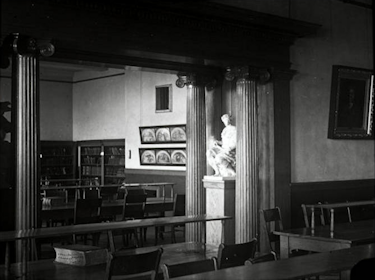
When Jessie attended and taught at the High School it had a much more formal feeling than I would expect to find at a school today. The photos in Nebraska Memories provide us with a glimpse of the ornate sculptures and artwork in the corridors and classrooms.
Even though I’ve already learned a lot about Jessie, I decided to do a couple of more searches. I’m happy I did because I found what I think is the most interesting piece of information. In 1913, Jessie presented at the nineteenth annual meeting of the Nebraska  Library Association. The article starts at the bottom of page 394 in Public Libraries, Volume 18. The article outlines the events of the two-day meeting that was held at the Omaha Public Library. Jessie presented a paper on the reading of high school students.
Library Association. The article starts at the bottom of page 394 in Public Libraries, Volume 18. The article outlines the events of the two-day meeting that was held at the Omaha Public Library. Jessie presented a paper on the reading of high school students.
The journal Libraries: A Monthly Review of Library Matters and Methods, Volume 19 provided a few more details about her presentation. Her paper was titled “Stimulation to reading for high-school students.” Her presentation and that of a coworker were “issued in pamphlet form by the Omaha public library.”
As I mentioned before Miss Jessie Towne retired in 1930. She passed away on July 8, 1957. She was survived by her sisters Miss Mary Towne of Omaha and Mrs. Fred Deweese of Lincoln.
While I was researching Jessie, I couldn’t help but find some information about her family. Here are few interesting tidbits of information that I found.
- Jessie’s father Dr. Solon R. Towne sounds like an interesting man. He served as president of both the Nebraska Audubon Society and the Nebraska Tuberculosis Association. You can read more about him in the article “Notes on Dr. Solon R. Towne and Early Bird Study in Omaha and Nebraska” in the April 1964 issue of The Nebraska Bird Review.
- Jessie’s mom Harriet was active in the Omaha Women’s Club and helped to start the Visiting Nurses’ Association in Omaha. You can see a photo of Harriet on page 3 of the document “The Omaha Visiting Nurses Association during the 1920s and 1930s”.
- I learned a bit about her sister Alice in the article “Physical Education for Women at Nebraska University, 1879-1923”. Alice attended and then worked at UNL. In 1908, she was appointed professor and director of the women’s gymnasium. The article contains two pictures of Alice.
Visit Nebraska Memories to search for or browse through many more historical images digitized from photographs, negatives, postcards, maps, lantern slides, books and other materials.
Nebraska Memories is a cooperative project to digitize Nebraska-related historical and cultural heritage materials and make them available to researchers of all ages via the Internet. Nebraska Memories is brought to you by the Nebraska Library Commission. If your institution is interested in participating in Nebraska Memories, see http://nlc.nebraska.gov/nebraskamemories/participation.aspx for more information, contact Devra Dragos, Technology & Access Services Director.
Throwback Thursday: Brandeis Building, Omaha, Nebraska.
Posted in General, Nebraska Memories
Leave a comment
Paving the Way
Spring is here and birds have been returning to Lincoln and building their nests. However, the rat-a-tat-tats I’ve been hearing aren’t all woodpeckers! It’s construction season for houses and roads. Lincoln’s 2015 population estimate was 277,348, up 7.3% from 2010; it is a seller’s market at the moment as the city continues to grow.
Between 1920 and 1930 Lincoln’s population increased by 38.2%. Although the annexation of Bethany Heights (1922), University Place (1926) and College View (1929) contributed about 8,000 of the 20,985 new Lincoln residents, there was still a definite need for more housing.
Sheridan Park, one new housing development, was organized by Harvey Rathbone, secretary and manager of Sheridan Park Investment Company and president of Rathbone Company (real estate). Now part of the Boulevards Historic District, Sheridan Park’s original plat map shows a rectangle bounded by South and Van Dorn Streets and 27th and 31st Streets, and includes several interior streets that curve and have medians. Sheridan Boulevard follows a geographical ridge with the streets on either side following the same line. The final layout was very close to that of the plat map, but a few streets have different names, and 31st Street, which became Winthrop Road, ended up with several curves in it. On the east side of Winthrop Road, Rathbone later created a subdivision called Rathbone Village; that name was sometimes used when referring to all of Rathbone’s development in this area. The photograph below shows Bradfield Drive, the north entrance to Sheridan Park/Rathbone Village, from South Street in 1923 (all historical photographs in this post are from the Townsend Studio Collection).

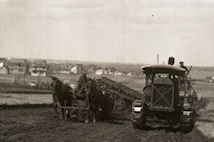 The first house on Bradfield Drive was built in 1917 and the last in 1940. Along the way, streets were cut and paved as needed. New machinery helped with the process, as seen in the photograph at right. With the brand name “Best” stamped above the grill, the machine used to pull the equipment that cut and lifted the sod has a motor and continuous tracks like a tank for traction. However, the wagons used to haul away the sod were still pulled by horses.
The first house on Bradfield Drive was built in 1917 and the last in 1940. Along the way, streets were cut and paved as needed. New machinery helped with the process, as seen in the photograph at right. With the brand name “Best” stamped above the grill, the machine used to pull the equipment that cut and lifted the sod has a motor and continuous tracks like a tank for traction. However, the wagons used to haul away the sod were still pulled by horses.
The side view of this machine shows its size and the equipment it is pulling. This second section has various rods and chains as well as three wheels shaped like a ship’s wheel that the men appear to be working. Instead of continuous treads, it has wheels–the back ones larger than the front. Abel Construction Co. is printed on the side of the second section. Abel Construction Company started as a paving contracting company in Lincoln in 1908 and is still in business today under the name Constructors, Inc.
 Along with brick-paved streets, the new housing division had other modern conveniences, such as electricity. Even though there is a windmill behind one of the bungalows in the photograph at the right, there are electric poles and lines running by the houses. Perhaps the reliability of the electricity was still a little iffy and the windmill was used like a backup generator.
Along with brick-paved streets, the new housing division had other modern conveniences, such as electricity. Even though there is a windmill behind one of the bungalows in the photograph at the right, there are electric poles and lines running by the houses. Perhaps the reliability of the electricity was still a little iffy and the windmill was used like a backup generator.
In addition to housing, people have various other needs. In the above photograph, at left in the distance behind the building with the smokestack, was the dancing pavilion at Antelope Park. The park eventually expanded to run down the length of the east side of the development and is part of the city’s current bike trail system. In 1925, Sheridan Elementary School was built in Sheridan Park on Plymouth Avenue, and Westminster Presbyterian Church was built a few blocks to the west on Sheridan Boulevard.
When you drive through the new housing developments today and see the little stick trees planted in the front yards, just think of how they will look 90+ years from now. As in the photo below taken at the South Street entrance to Bradfield Drive, you won’t be able to see the houses for the trees!
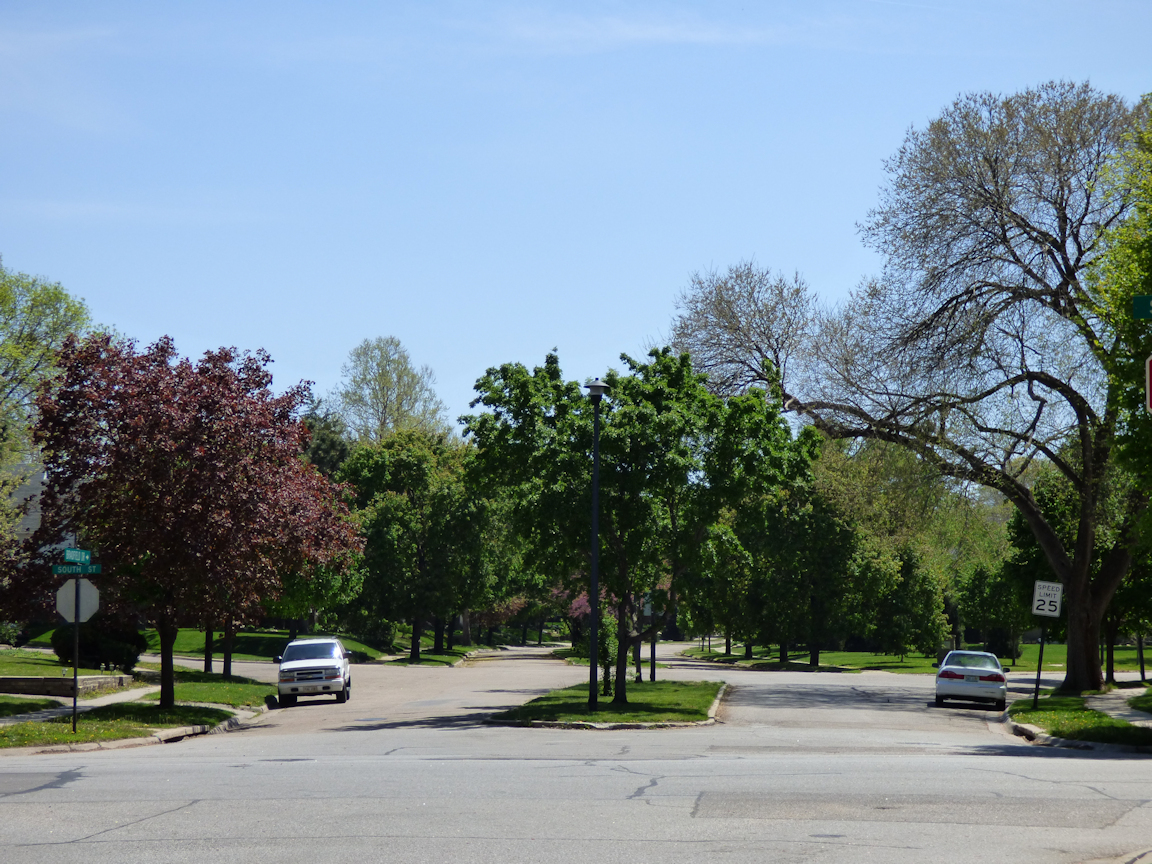
Visit Nebraska Memories to search for or browse through many more historical images digitized from photographs, negatives, postcards, maps, lantern slides, books and other materials.
Nebraska Memories is a cooperative project to digitize Nebraska-related historical and cultural heritage materials and make them available to researchers of all ages via the Internet. Nebraska Memories is brought to you by the Nebraska Library Commission. If your institution is interested in participating in Nebraska Memories, see http://nlc.nebraska.gov/nebraskamemories/participation.aspx for more information, contact Devra Dragos, Technology & Access Services Director.
Posted in Nebraska Memories
Leave a comment
